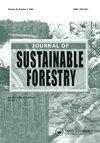Growth and Coppicing Ability of the Critically Endangered Agarwood (Aquilaria Malaccensis Lam.) Tree in Monoculture and Polyculture in North East India
IF 1.8
4区 农林科学
Q3 FORESTRY
引用次数: 1
Abstract
ABSTRACT Agarwood (Aquilaria malaccensis Lam.) (Thymelaeaceae) is valued in many cultures because of its distinctive fragrance and its use in incense, perfumery, and traditional medicine. Large-scale harvesting from natural populations caused rapid depletion of the species in the wild, and the species is now listed as “Critically Endangered” and almost extinct in the wild. The promotion of this species in agroforestry systems may pave the way for its conservation. The present study aimed to quantify the growth and coppicing ability of agarwood under monoculture and polyculture stands. Monoculture stands aged more than 20 years, and stem girth (1.37 m above ground) of 60–70 cm had the highest growth increment of 3.73 cm yr−1. Monoculture stands (>10 years old) also recorded higher number of coppicing stocks than polyculture stands. The highest coppice growth increment (4.07 cm yr−1) was recorded in the 70–80 cm stem girth in monoculture stands. Based on the results, we recommend the promotion of agarwood trees with good coppice management in forestry programs to conserve the species while also meeting the economic needs of rural communities.印度东北部极度濒危Agarwood(Aquilaria Malacensis Lam.)树在单一和复合栽培中的生长和覆铜能力
琼脂(Aquilaria malacensis Lam.)(百里香科)因其独特的香味以及在香、香水和传统医学中的应用而在许多文化中受到重视。从自然种群中大规模采集导致该物种在野外迅速枯竭,该物种现在被列为“极度濒危”物种,在野外几乎灭绝。在农林系统中推广该物种可能为其保护铺平道路。本研究旨在量化单一栽培和混合栽培林分下沉香木的生长和coppicing能力。年龄超过20年、茎围(离地1.37米)为60–70厘米的单一栽培林分的生长增量最高,为3.73厘米yr−1。单一栽培林分(>10年树龄)也记录了比混合栽培林分更高的群落种群数量。在单作林分中,70–80 cm的茎围记录到最高的矮林生长增量(4.07 cm yr−1)。根据研究结果,我们建议在林业项目中推广具有良好矮林管理的沉香树,以保护该物种,同时满足农村社区的经济需求。
本文章由计算机程序翻译,如有差异,请以英文原文为准。
求助全文
约1分钟内获得全文
求助全文
来源期刊

Journal of Sustainable Forestry
Social Sciences-Geography, Planning and Development
CiteScore
3.90
自引率
12.50%
发文量
42
期刊介绍:
Journal of Sustainable Forestry publishes peer-reviewed, original research on forest science. While the emphasis is on sustainable use of forest products and services, the journal covers a wide range of topics from the underlying biology and ecology of forests to the social, economic and policy aspects of forestry. Short communications and review papers that provide a clear theoretical, conceptual or methodological contribution to the existing literature are also included in the journal.
Common topics covered in the Journal of Sustainable Forestry include:
• Ecology, management, recreation, restoration and silvicultural systems of all forest types, including urban forests
• All aspects of forest biology, including ecophysiology, entomology, pathology, genetics, tree breeding, and biotechnology
• Wood properties, forest biomass, bioenergy, and carbon sequestration
• Simulation modeling, inventory, quantitative methods, and remote sensing
• Environmental pollution, fire and climate change impacts, and adaptation and mitigation in forests
• Forest engineering, economics, human dimensions, natural resource policy, and planning
Journal of Sustainable Forestry provides an international forum for dialogue between research scientists, forest managers, economists and policy and decision makers who share the common vision of the sustainable use of natural resources.
 求助内容:
求助内容: 应助结果提醒方式:
应助结果提醒方式:


